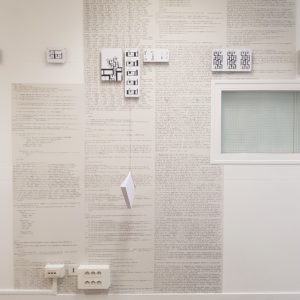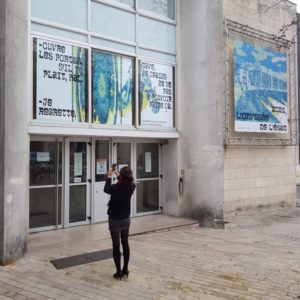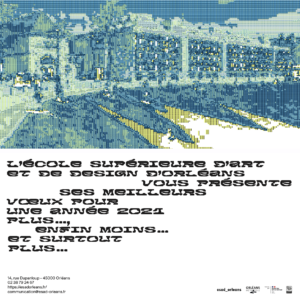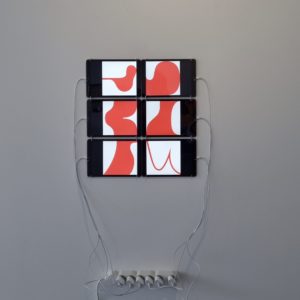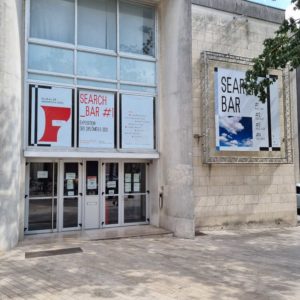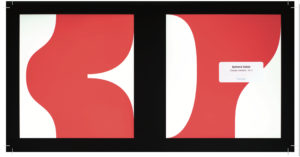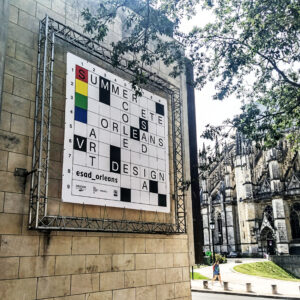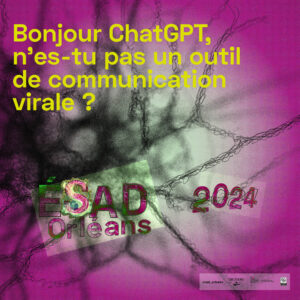Since 2019, ÉSAD Orléans has been bending the rules of communication. Our school doesn’t have a visual identity… Or rather, it’s renewed every year, insofar as the world of art and design is itself made up of worlds in motion, plural, polymorphous… Year after year, therefore, the visual identities of ÉSAD Orléans overlap and intermingle.
The principle: every year, the school’s visual and graphic identity is entrusted to a young graduate, a duo or a collective. It’s also an opportunity to enrich our web library.
Summary of the story.
2019-2020: a double whammy
In 2019, ÉSAD decided to completely overhaul its website. This will be the starting point for the school’s new identity. At the same time, the school breaks with the sacrosanct principle of a single, enduring visual identity by imagining two interchangeable themes for its website.
The first theme was entrusted to Noé Oréglia, a freelance designer, and the second to a group of 4th year students (Antoine Buon, Laëtitia Cuchet, Éléonore Fines and Lucie Sahuquet), supervised by a teacher, Nicolas Girard. To reflect the school’s new direction, Noé Oréglia, in collaboration with Emmanuel Guez, thought of the film Matrix. The ÉSAD logotype was designed in the spirit of the no logo (see the logotype on this site).
At the same time, the group of students, joined by two others, Mégane Lazou and Hugo du Roure, was asked to create the visual identity for the Journées Portes Ouvertes (JPO) 2020. The design was inspired by the façade of the main building on rue Dupanloup.
Following a workshop with graphic designer Quentin Juhel, the group produced signage, printed materials (posters, 4×3 tarpaulins, greetings cards, etc.), typography, animations, a theme for the “matrix” website, the theme for the exhibition website and the 2020 student booklet in WebToPrint. The black and white visual identity is also being used by Marlène Bertoux, head of the computer graphics workshop, for the first two exhibitions in the Uncool Memories cycle (2020-21).
An exhibition in September 2020 retrace the entire project (see image above).
2020-21: Adrien Jacquemet and Basile Jesset
In 2020, it’s the turn of two young graduates, Adrien Jacquemet (DNSEP 2019) and Basile Jesset (DNSEP 2020, student-researcher in DSRD) to work on the visual and graphic identity of ÉSAD Orléans.
The duo set themselves the goal of designing a visual identity that escaped the production modes proposed by the Adobe license and could be adapted to all distribution media. They developed a variable typography and an image generation tool. The latter uses the visuals produced by ÉSAD to compose a new image that creates an identity. Typography and visuals respond to each other via a variable grid that can be adapted to different media.
The identity is refined over the course of the year by the addition of various stages in the production process, such as the management of colorimetric profiles, new framing options and pre-program routing phases.
Focusing on blues and greens, the duo created two 4×3 tarpaulins (see below), the 2021 greetings card (see below), the visual and graphic design of the last three exhibitions in the Uncool Memories cycle, the JPO 2021 website, the 2021-22 booklet and the 2021 Yearbook.
2021-22: Nicolas Lemaitre
Nicolas Lemaitre (DNSEP 2021) has been entrusted with the visual identity for the 2021-22 year.
His first projects include Search Bar #1 – the 2021 graduates’ exhibition, where one of his own projects is on display (see below).
2022-23: Nicolas Lemaitre
Nicolas Lemaitre (DNSEP 2021) has once again been entrusted with the visual identity for the 2022-23 year, appropriating the year’s playful theme “U.S.B” for “Uno – Simon – Bic”, 3 games/objects referencing 4 colors.
2023-24: Make way for artificial intelligence
For 2023-2024, the visual identity of ÉSAD Orléans is created by the team from the EMD program (Editions, Média, Design) at ÉSAD Orléans. It uses artificial intelligence to create its texts and images. Developed as part of the SUI GENERIS project, it draws on the viral and organic dimension of the Physarum polycephalum or Blob to create a parallel with the generative images created by the CHAT-GPT conversational agent.
What’s more, the spirit is resolutely punk. And, as everyone knows, punk doesn’t really play by the rules…
This year’s theme is the Blob, which is both a living reticular being (Physarum polycephalum) and a computer object (short for Binary Large Object), which refers to a mass of data in binary form. The networks generated by the Physarum demonstrate a real capacity for engineering, and it is thus considered a “form of primitive intelligence”: it moves, self-regenerates, finds its way in a labyrinth, remembers and anticipates. Viral (or almost), organic and astonishing, the blob remains a mysterious being.
Computer BLOBs, on the other hand, are lightweight, immutable objects that can efficiently store data, making them suitable for handling large files such as images, audio or video files. Blobs are supported by modern web browsers and can be used for a variety of purposes, as they are highly flexible.
From the networks of the Physarum to the blobs of the Internet, thanks to which A.I. is open to the public, there is perhaps only one and the same line. Welcome to the world of blobs (punks)!


